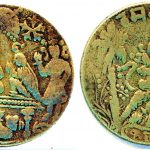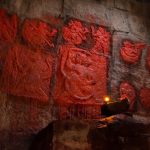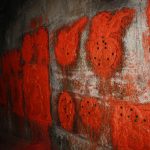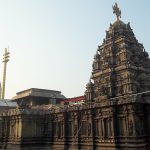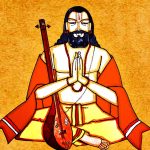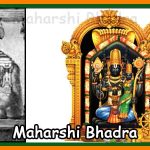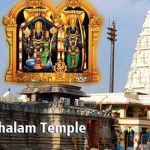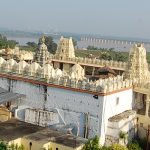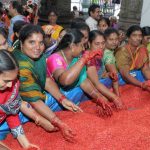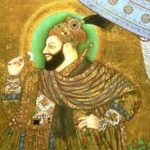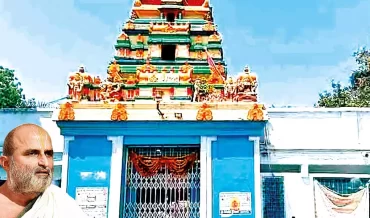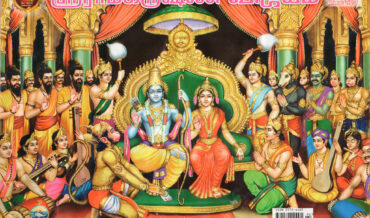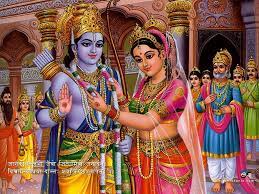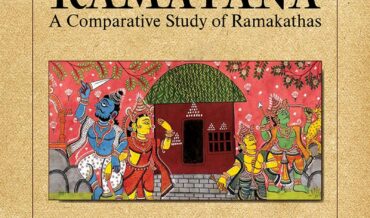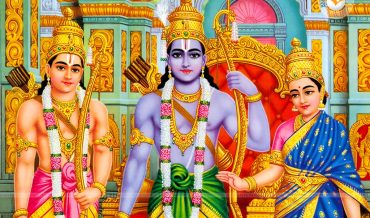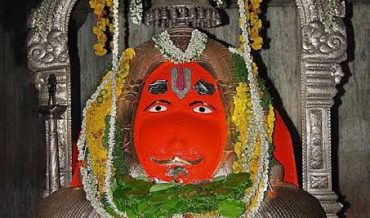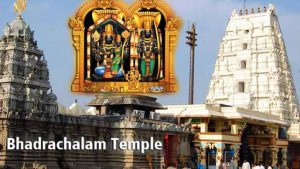
Main deity – Bhadrachalam
Main Deity: Sri Ram, Lakshman and Maa Sita
A sacred place that attracts lakhs of devotees from all over the world, it is the abode of Bhagwan Sri Sri Rama (The seventh Avtar of Sri Mahavishnu). This hill place which is encircled by holy river Godavari flowing towards southern direction is the famous shrine Bhadrachalam. Bhadrachalam also popularly known as Dakshina Ayodhya
The name derived from Bhadragiri (Mountain of Bhadra – a boon child of Meru and Menaka). According to a Ithihasas, the significance of this shrine dates back to Sri Ramayana Era. This coherent hill place existed in “Dandakaranya” Of Sri Ramayana period where Sri Rama with His consort Maa Sita and brother Lakshmana had spent their vanavasa- and Parnashaala (the place connected to the famous Golden Deer and the place from where Sita was abducted by Ravana) is also in the vicinity of this Temple site. It is at this Mandir site that, long after Sri Ramavatara, Bhagawan Mahavishnu manifested Himself as Sri Rama again to fulfil a promise He made to His Bhakta Bhadra, who continued his Tapas through Yugas, praying for the grace of the Bhagawan Sri Sri Ramachandra murthy.
Exigency of Incarnation
The Sattology depicts that the need emerged the incarnation of Vykuntha Sri Rama was that to fulfill a long desire of his ardent Bhaktha Sri Bhadra.
Maharshi Bhadra
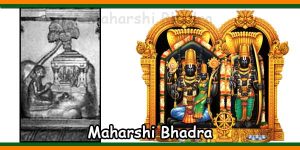
Maharshi-Bhadra
Bhadra performed tapas (penance) at the bank of river Godavari in this ” Dandakaranya ” to get grace of Bhagwan Sri Rama and in countenance of his beloved God – The exulted “Rishi” implored Sri Rama to be seated on his head, but Sri Rama who was in search of His consort Sita gave promise to his Bhakta that his desire would be fulfilled on his way back, after finding Sita and accomplishing the process of punishing the wicked Ravana and establish ‘Dharma’. Thus the sage had been in continuation of the frightened penance as Sri Rama could not accomplish the promise in Sri Ramavatara . Then Sri Mahavishnu manifested himself as Vykuntha Sri Rama and rushed to his devotee Bhadra , signaling his arrival by blowing ‘Shank’,accompanied by His consort Maa Sita and brother Lakshmana, resembling that of ‘Gajendra Moksham ‘ from Srimad Bhagawatam – Thus , the Moorthies of Sri Rama ( having four hands ) – Shanku on the right , Chakra at his left and Dhanurbhana ( Bow and Arrow in the rest two hands ) , Sita had condescended on the left lap of Sri Rama and brother ( at Sri Rama’s left ) are existed . And the hill place where the Deities were seated on, was the head place of Bhadra – achalam ( achalam means hill ) ,thus this shrine was transformed into Bhadrachalam .
The idols of Vykuntha Sri Rama, Lakshmana and Sita were found by Pokala Dhammakka.
Pokala Dhammakka,
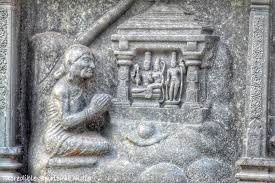
Pokala Dhammakka
an ardent devotee of Sri Rama lived in the 17th century and was an inhabitant of Bhadrireddypalem, a mile away from this holy place. On one fine night, she had darshan of Sri Rama in her dream who said “Maharishis are worshiping my embodied moorthy settled on Bhadragiri” and asked her to trace them, perform pooja and attain Moksha. On the very next day morning she started searching for the idols-peeped into an ant-hill and found the idols hidden in it. She poured hundreds of pots of Godavari water on the ant-hill which tardily dissolved and gave way for the appearance of the hidden Deities. Since then, she used to perform pooja daily and offer ‘naivedyam’ with fruits fallen from near palmyra tree and constructed a mandapam of thatch hut with the help of local villagers. Bhagawan Sri Rama told Dhammakka that at a later date, one of his devotees would construct a Mandir at this site. Dhammakka waited patiently for the devotee. The devotee turned out to be Bhakta Sri Ramadas.
Bhakta Sri Ramadas and construction of Temple
Bhadrachala Sri Rama Temple was constructed by Kancharla Gopanna popularly known as Bhakta Sri Ramadas in the year 1674 A.D.
Who is Bhakta Raamadas alias Kancharla Gopanna?
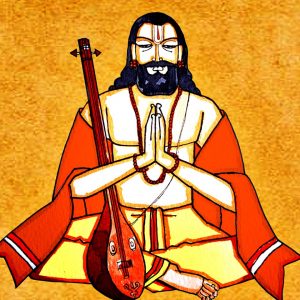
bhadrachala_ramadasu
Kancharla Gopanna, popularly known as “Bhakta Ramdas”, a fervent Bhaktha of Sri Rama, was born to Sri Linganna Murthy and Smt Kamamba in Nelakondapalli village of Khammamett Taluk in 17th century (1620 AD). Since childhood, he imbibed his family’s interest in spirituality and composed several keertanas on Sri Rama. His devotion to Vaikunta Rama at the Temple of Bhadrachalam, a small village in the middle of the jungle on the northern banks of the holy river Godavari, earned him his name Bhadraacala Raamadaas. His Guru was Raghunatha Bhattacharya. He was nephew of Akkannna, the administrative head in the court of Nawab Abul Hussan shah known as ‘Taneshah‘ of Golkonda (Now Hyderabad) (he was the last ruler of Golconda before Aurangazeb captured it in 1687A.D.) and was appointed by him as Tahsildar of ‘Palvoncha Paragana’. Thus he was discharging his official duties earnestly and collecting revenues due to the Nawabs in continuation of daily preaches -Chanting of ‘Sri Ramanama‘ and the feeding the poor at his house. which included Bhadrachalam, a pretty and picturesquely situated Temple town on the Godavari river.
How Bhakta Ramadas got connected with Bhadrachalam?
Sri Ramadasa, who heard the news that the villagers of palvoncha paragana were proceeding to witness a Jatara at Bhadrachalam , became curios and he too visited Bhadrachalam. He found the deities in an amazing appearance. Sri Ramadas, then asked the villagers to contribute liberally for the construction of the Temple. After the contributions were found to be insufficient, the villagers appealed him to spend the revenue collections for the construction of the Temple with a promise to repay the amount after harvesting the crops. Accordingly, Sri Ramadas constructed the Temple with an amount of Rs 6 Lakhs collected from the land revenues with out the permission of the Nizam Nawab.
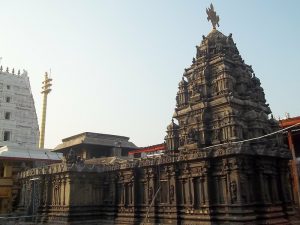
Main Sanctom with Sudarshana Chakra
When the Temple reached to the nearing completion, he had a problem of fixing ‘Sudarshana Chakra‘ at the crest of the main Temple (Gopuram Vimanam). He was deeply distressed and fell into sleep. On the same night, Sri Rama in his dream asked him to have a holy dip in river Godavari where he will find that-accordingly. On the next day morning Gopanna did so and found holy Sudarshana Chakra in the river with out much difficulty. He presumed that Sudarshana Chakra itself was shaped up with the divine power of his beloved Bhagwan Sri Rama.
Immediate completion of Temple, Sri Ramadas’s miseries started
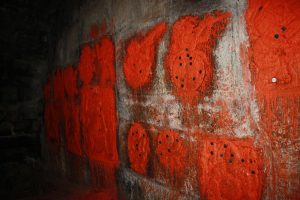
Golconda fort1
Soon after the construction, his miseries started. As He collected money for the construction from the citizens, but was not enough. So he borrowed from the tax revenue of the nawab and gave his god a worthy abode, vowing to return the money. However, the nawab was furious and sentenced Ramadas to 12 years in prison and was tortured. Raamadaas thus earned the name Bandikhana Raamadaas (meaning imprisoned Ramadas). Frustrated at God’s indifference to his pleadings, Ramadas composed some of the finest keertanas in his prison cell (reminding Rama of his services in Ikshvaku Kula Tilaka). Unable to withstand the miseries, Sri Ramadas implored Sri Rama to relieve him by singing many praising and emotional songs which got popularized from the stanzas of ‘Dasaradhi Sathakam’ and ‘Keertanas’ of Bhakta Sri Ramadasa.
Sattology and Miracle experienced by Nawab
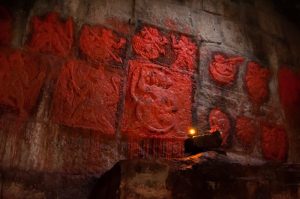
Golconda fort
The Nizam Nawab Tanishah, the then ruler of Nizam’s territory became a devotee of Sri Rama who realized the devotion spirit of Sri Ramadas after his imprisonment and took over the charge of Temple administration. This resembles the communal harmony among the Hindus and Muslims. The Nizam Nawab realized Sri Ramadas devotional spirit and dedication towards Sri Rama, when Sri Rama and Lakshmana repaid 6 lakh Mohurs exposing themselves as Ramoji and Laxmoji, the servants of Bhakta Sri Ramadas to get release of their devotee from the imprisonment. The golden coins paid by Rama are known as Ram Tanka coins. (Those two can still be seen kept in Bhadrachala Sri Sita Sri Ramachandra Swamy vaari Devasthanam). These coins have the Pattabhishekam scene on one side and the picture of another Rama Bhaktha, Hanuman, on the other side. Thanisha gave voucher to these divine looking persons who approached him at his house during late night in his dreams. Then they kept the voucher under the pillow of Gopanna where he was jailed. Tanishah who woke up on the very next day morning realized that those divine looking persons were none other than Sri Rama and Lakshmana and made arrangements to get release of Gopanna and prayed to forgive him by placing all the Gold Mohurs received last night at the feet of Gopanna. But, he refused to take back those mohurs except two as a mark of divine significance.
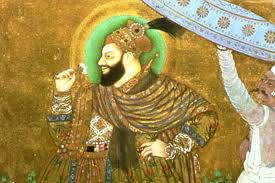
Tana Shah of Golconda
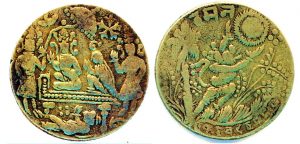
Rama tanka coins
Influenced by the majesty of Bhagwan Sri Rama, Golkonda Ruler Tanishah earmarked the income derived from the said Palwoncha paragana which came to Rs 20,000 and odd for the maintenance of the Temple which was continued during Nizam’s reign and offering Pearls (Mutyala Talambralu) on the occasion of kalyana mahotsavam (Sri Sri Rama Navami) to Deities on an elephant through a specially sent messenger. That procedure of sending pearls to the Deities is still followed by present state Government and continues to offer during Sri Sri Rama Navami Festival (Kalyana mahotsavam). Tumu Narsimha Dasa, Tahasildar of Palwoncha paragana, along with his associate Varada Sri Ramadasa came here from Guntur and took over the charge of Bhadrachala Sri Rama Temple after Sri Ramadas made inscripted the performance of Nitya Poojas and sevas right from early morning “Suprabhata Seva” till night “Pavalimpu Seva” before closure of the Temple as “Silaasaasanaalu” on these two pillars. This inscription gives details of daily dictum and daily rituals also.
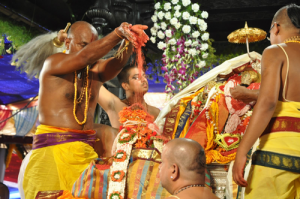
Sri Rama Navami
Ramadas spent the rest of his life on these lands and composed further moving poems that were to inspire Tyaagaraaja: in ksheera saagara sayana in Devagaandhaari, he says “Dhirudau Ramadasuni Bandhamu dirchinadi Vinnanura Rama?” (O Rama! I have heard how You obtained the release of the bold Ramadas from his prison life); in brindaavanalOla in tODi, in kaligiyundE gada in keeravaaNi, in Emi dova balkuma in saaranga and in Prahlaada Bhakti Vijayam he says “kaliyugamuna vara bhadra calamuna nelakonna raamacandruni pada bhaktula kella varudanandagi velasina shree raamadaasu vinutintu madin” (I praise Sri Raamadaas, who shines in this world as the supreme devotee of Sri Raamachandra, who shines forth from his seat at Bhadraachalam in this kali Yuga).
Other compositions are positive invocations, favored by traveling minstrels, including the Tondaiman rulers of Pudukottai in Tamil Nadu, who popularized his songs. Among his other accomplishments is the creation of the whole Ramayana story in the form of a prose-poem, a Choornika. Ramadas described himself in this way in the last verse of his Dasarathi Satakam: “Allana Linga Mantri Suthudu (son), Atreya Gothrudu, Adi Sakha, Kancherla Kulothbhavudu, Gopakavindrudu.” Shri Bhadraachala Raamadaas attained Moksha in His 68 years .
How to reach this Temple – Location from Google maps – Click here
Image Source: Flickr and Google
Information Source: Temple Website & my known knowledge
- Sri Rama Navami
- Rama tanka coins
- Golconda fort
- Golconda fort1
- Main Sanctom with Sudarshana Chakra
- bhadrachala_ramadasu
- Pokala Dhammakka
- Maharshi-Bhadra
- Main deity – Bhadrachalam
- Bhadrachalam Temple
- mutyala-talambralu – Pearl Talambralu
- Tana Shah of Golconda
Here is a small video about 10 unknown facts of Bhadrachalam Temple from Youtube
All information entered is personal to the author. Any modification or changes must be addressed to the author.



